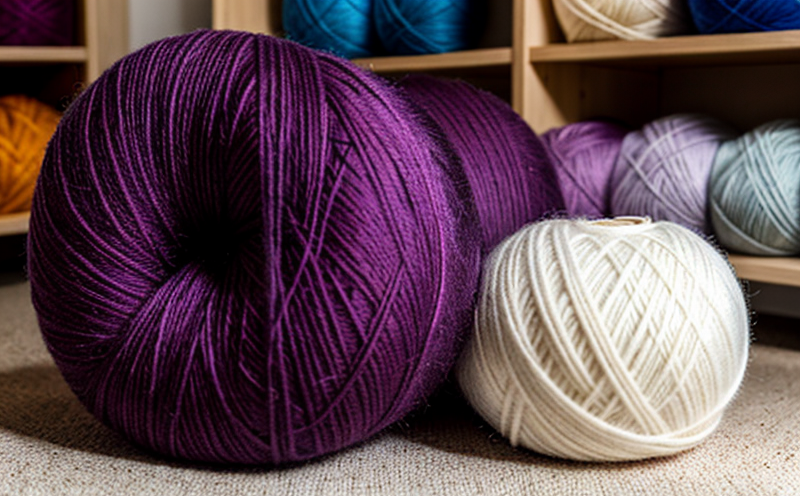DIN 53835 Yarn Breaking Force Measurement
The DIN 53835 standard is a crucial method used in textile manufacturing and quality control to measure the breaking force of yarns. This test assesses the tensile strength of yarn by determining the maximum load it can withstand before it breaks. The procedure involves placing the yarn under tension until failure, recording the peak force at which this occurs.
Breaking force is a key parameter in evaluating the quality and durability of textile products. It directly influences the performance and longevity of garments, fabrics, and other textiles used in various sectors like fashion, automotive, and home furnishing. The measurement of breaking force helps manufacturers ensure that their yarns meet the required standards for strength and reliability.
The test is applicable to a wide range of synthetic and natural fibers, including cotton, polyester, nylon, and more. It plays an important role in the quality assurance process by providing objective data on the physical properties of the yarn. This information is vital for R&D engineers who are developing new materials or improving existing ones.
For compliance officers, ensuring that their products meet international standards such as DIN 53835 is essential to maintaining a good reputation and avoiding regulatory issues. In addition, this test supports procurement decisions by helping companies select suppliers whose yarns meet the necessary quality benchmarks.
The testing process typically involves the following steps:
- Selection of appropriate samples based on the type of yarn being tested
- Careful preparation of the yarn sample to ensure it is free from defects
- Calibration and setup of the tensile tester according to manufacturer’s instructions
- Application of tension to the yarn until failure while recording force data
- Data analysis to determine the breaking force value
The results are reported in Newtons (N) or kiloNewtons (kN), depending on the scale used. A higher breaking force indicates stronger yarn, which translates into better quality and durability.
Understanding real-world applications of this test is crucial for those involved in textile manufacturing and testing. For instance, a clothing manufacturer might use DIN 53835 to ensure that the fabric they are using will hold up well under various conditions such as washing or stretching. Similarly, an automotive company may require high-strength yarns for safety-critical components like seat belts.
Compliance with international standards is increasingly important in today’s global market. By adhering to standards like DIN 53835, companies can demonstrate their commitment to quality and reliability, which builds trust among consumers and stakeholders alike.
Benefits
The implementation of DIN 53835 in textile manufacturing offers numerous advantages. Firstly, it ensures consistent product quality by providing a standardized method to measure yarn strength. Secondly, it supports compliance with international standards, which is increasingly important for global markets.
- Enhanced Quality Control: By measuring breaking force, manufacturers can identify weak points in their processes and address them proactively.
- Better Product Performance: Stronger yarns lead to more durable products, enhancing customer satisfaction.
- Competitive Edge: Adhering to high-quality standards like DIN 53835 can give manufacturers a competitive advantage in the marketplace.
In addition to these benefits, regular testing helps prevent costly errors and recalls. It also fosters innovation by allowing companies to experiment with new materials while ensuring they meet necessary quality criteria.
Quality and Reliability Assurance
- Consistent Results: DIN 53835 ensures that the breaking force of yarns is measured consistently across different testing facilities. This consistency allows for reliable comparisons between samples.
- Reproducibility: The standardized procedure guarantees reproducible results, making it easier to track trends over time and identify improvements needed in production processes.
- Compliance Verification: Regular testing helps verify that products meet the required standards, ensuring compliance with local regulations and international agreements.
These aspects of quality and reliability are critical for maintaining a positive brand image and building consumer trust. By investing in DIN 53835 compliant testing, companies can ensure their products consistently meet or exceed expectations.
Customer Impact and Satisfaction
- Improved Product Durability: Consumers benefit from products that last longer due to the enhanced durability provided by strong yarns. This leads to greater customer satisfaction.
- Higher Quality Products: Compliance with DIN 53835 ensures that textiles are of high quality, which is important for maintaining a loyal customer base.
- Increased Trust: By adhering to international standards, companies build trust among consumers who value reliability and safety in the products they purchase.
The impact on customers extends beyond just product performance. It includes peace of mind knowing that their purchases meet rigorous quality standards, which contributes significantly to overall customer satisfaction and loyalty.





